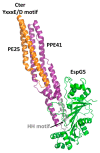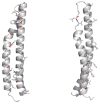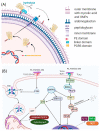PE_PGRS33, an Important Virulence Factor of Mycobacterium tuberculosis and Potential Target of Host Humoral Immune Response
- PMID: 33467487
- PMCID: PMC7830552
- DOI: 10.3390/cells10010161
PE_PGRS33, an Important Virulence Factor of Mycobacterium tuberculosis and Potential Target of Host Humoral Immune Response
Abstract
PE_PGRS proteins are surface antigens of Mycobacterium tuberculosis (Mtb) and a few other pathogenic mycobacteria. The PE_PGRS33 protein is among the most studied PE_PGRSs. It is known that the PE domain of PE_PGRS33 is required for the protein translocation through the mycobacterial cell wall, where the PGRS domain remains available for interaction with host receptors. Interaction with Toll like receptor 2 (TLR2) promotes secretion of inflammatory chemokines and cytokines, which are key in the immunopathogenesis of tuberculosis (TB). In this review, we briefly address some key challenges in the development of a TB vaccine and attempt to provide a rationale for the development of new vaccines aimed at fostering a humoral response against Mtb. Using PE_PGRS33 as a model for a surface-exposed antigen, we exploit the availability of current structural data using homology modeling to gather insights on the PGRS domain features. Our study suggests that the PGRS domain of PE_PGRS33 exposes four PGII sandwiches on the outer surface, which, we propose, are directly involved through their loops in the interactions with the host receptors and, as such, are promising targets for a vaccination strategy aimed at inducing a humoral response.
Keywords: infectious disease; protein structure; tuberculosis; vaccine.
Conflict of interest statement
The authors declare no conflict of interest. The funders had no role in the design of the study; in the collection, analyses, or interpretation of data; in the writing of the manuscript, or in the decision to publish the results.
Figures







Similar articles
-
Evaluation of PE_PGRS33 as a potential surface target for humoral responses against Mycobacterium tuberculosis.Pathog Dis. 2017 Nov 30;75(8). doi: 10.1093/femspd/ftx100. Pathog Dis. 2017. PMID: 28911035
-
Execution of macrophage apoptosis by PE_PGRS33 of Mycobacterium tuberculosis is mediated by Toll-like receptor 2-dependent release of tumor necrosis factor-alpha.J Biol Chem. 2007 Jan 12;282(2):1039-50. doi: 10.1074/jbc.M604379200. Epub 2006 Nov 9. J Biol Chem. 2007. PMID: 17095513
-
Functional dissection of protein domains involved in the immunomodulatory properties of PE_PGRS33 of Mycobacterium tuberculosis.Pathog Dis. 2013 Dec;69(3):232-9. doi: 10.1111/2049-632X.12096. Epub 2013 Oct 7. Pathog Dis. 2013. PMID: 24106104
-
A PE_PGRS33 protein of Mycobacterium tuberculosis: an ideal target for future tuberculosis vaccine design.Expert Rev Vaccines. 2015 May;14(5):699-711. doi: 10.1586/14760584.2015.1015995. Epub 2015 Feb 19. Expert Rev Vaccines. 2015. PMID: 25693607 Review.
-
PE_PGRS: Vital proteins in promoting mycobacterial survival and modulating host immunity and metabolism.Cell Microbiol. 2021 Mar;23(3):e13290. doi: 10.1111/cmi.13290. Epub 2020 Dec 1. Cell Microbiol. 2021. PMID: 33217152 Review.
Cited by
-
A Structural View at Vaccine Development against M. tuberculosis.Cells. 2023 Jan 14;12(2):317. doi: 10.3390/cells12020317. Cells. 2023. PMID: 36672252 Free PMC article. Review.
-
Next-Generation TB Vaccines: Progress, Challenges, and Prospects.Vaccines (Basel). 2023 Jul 31;11(8):1304. doi: 10.3390/vaccines11081304. Vaccines (Basel). 2023. PMID: 37631874 Free PMC article. Review.
-
Novel Targets for the Development of Tuberculosis Vaccine.Curr Drug Discov Technol. 2025;22(3):e070624230860. doi: 10.2174/0115701638285518240601075811. Curr Drug Discov Technol. 2025. PMID: 38859789 Review.
-
The Role of TLR2 in Infectious Diseases Caused by Mycobacteria: From Cell Biology to Therapeutic Target.Biology (Basel). 2022 Feb 5;11(2):246. doi: 10.3390/biology11020246. Biology (Basel). 2022. PMID: 35205112 Free PMC article. Review.
-
Immunological effects of the PE/PPE family proteins of Mycobacterium tuberculosis and related vaccines.Front Immunol. 2023 Sep 27;14:1255920. doi: 10.3389/fimmu.2023.1255920. eCollection 2023. Front Immunol. 2023. PMID: 37841250 Free PMC article. Review.
References
-
- World Health Organization The End TB Strategy. [(accessed on 14 January 2021)]; Available online: https://www.who.int/tb/strategy/en/
Publication types
MeSH terms
Substances
LinkOut - more resources
Full Text Sources
Other Literature Sources

